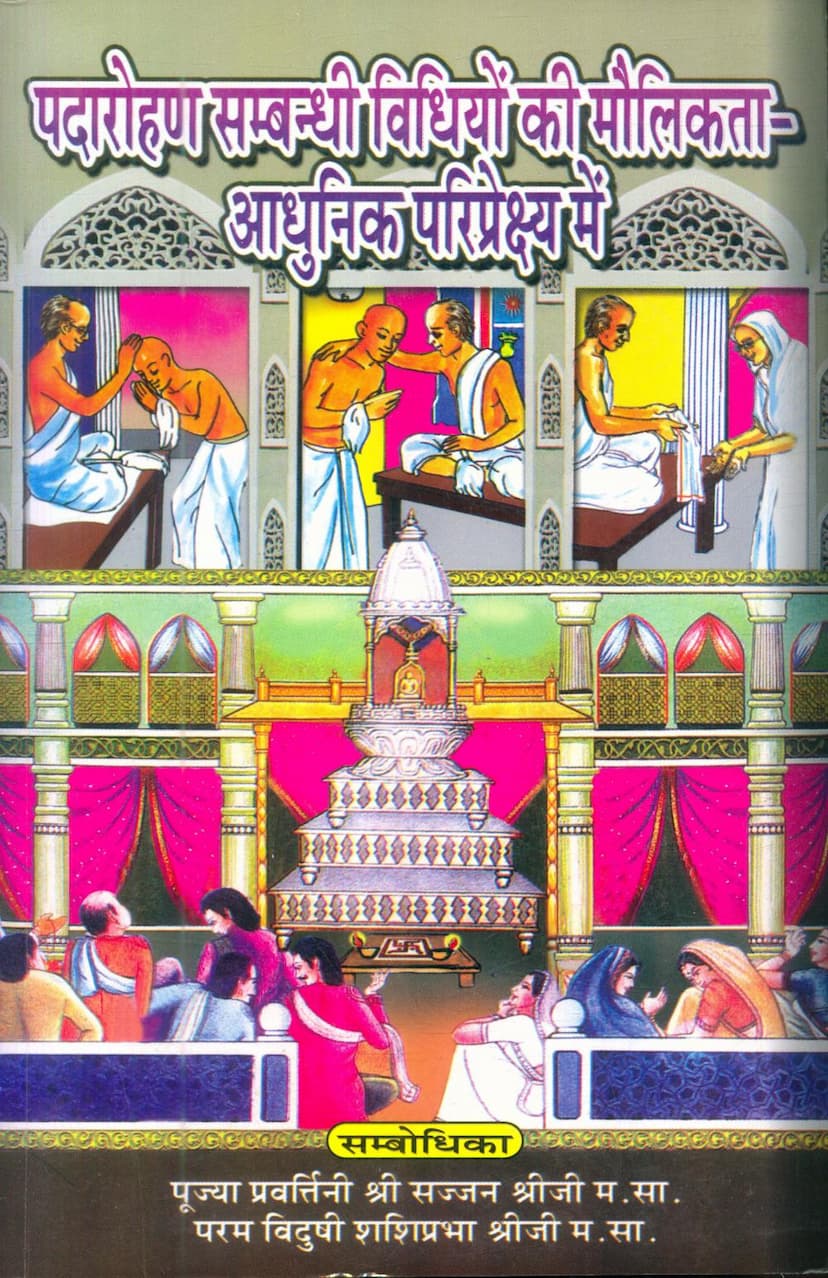Padarohan Sambandhi Vidhiyo Ki Maulikta Adhunik Pariprekshya Me
Added to library: September 2, 2025

Summary
Here's a comprehensive summary of the Jain text "Padarohan Sambandhi Vidhiyo Ki Maulikta Adhunik Pariprekshya Me" (The Originality of Installation Rituals in Jainism in a Modern Context), authored by Saumyagunashreeji and published by Prachya Vidyapith:
Overall Theme:
The book is the seventh volume in a series on Jain law and rituals, focusing specifically on the originality and modern relevance of installation rituals (Padorohan Vidhi) within Jainism. It is a scholarly work presented as a research thesis for a D.Litt. degree, aiming to provide a comparative and critical study of Jain legal procedures related to the installation of various office-bearers within the Jain tradition.
Key Focus of Volume 7:
This particular volume, "Padarohan Sambandhi Vidhiyo Ki Maulikta Adhunik Pariprekshya Me," delves into the "mysteries and originality of installation rituals" within the modern perspective. It appears to cover the rules and procedures for the installation of various key positions within the Jain monastic orders (Shraman Sangh).
Structure and Content (Based on the Table of Contents and Chapter Titles):
The book is structured into eleven chapters, each addressing a specific aspect of the installation rituals:
- Chapter 1: Pad Vyavastha Ka Ek Vimarsh (A Discussion on the System of Positions): This introductory chapter likely sets the stage by discussing the concept of positions and hierarchies within the Jain monastic system, tracing its origins and evolution.
- Chapter 2: Vachana Dan Evam Grahana Vidhi Ka Maulik Swaroop (The Fundamental Nature of the Ritual of Giving and Receiving Vachana): This chapter focuses on the ritual of "Vachana," which refers to the impartation of scriptural knowledge. It details the procedures, qualifications of the giver and receiver, and the benefits derived from this ritual.
- Chapter 3: Pravartak Padsthapana Vidhi Ka Marmik Swaroop (The Profound Nature of the Ritual of Installing a Pravartak): This chapter likely explains the installation process for a "Pravartak," a position of leadership and guidance within the monastic community.
- Chapter 4: Sthavir Padsthapana Vidhi Ka Paramparik Swaroop (The Traditional Nature of the Ritual of Installing a Sthavir): This chapter focuses on the installation of a "Sthavir," a senior and respected monk, likely emphasizing the traditional aspects of this ritual.
- Chapter 5: Ganavachchhedak Padsthapana Vidhi Ka Prachin Swaroop (The Ancient Nature of the Ritual of Installing a Ganavachchhedak): This chapter delves into the installation of a "Ganavachchhedak," a role related to the management and oversight of the monastic community (Gachha).
- Chapter 6: Gani Padsthapana Vidhi Ka Rahasyamayi Swaroop (The Mysterious Nature of the Ritual of Installing a Gani): This chapter explores the installation of a "Gani," often considered the head of a monastic sect or lineage (Gachhadhipati). The title suggests a focus on the deeper, perhaps less commonly understood, aspects of this ritual.
- Chapter 7: Upadhyay Padsthapana Vidhi Ka Vaigyanik Swaroop (The Scientific Nature of the Ritual of Installing an Upadhyay): This chapter focuses on the installation of an "Upadhyay," a highly learned scholar and teacher within the monastic order. The title implies an examination of the rationale and methods behind this ritual.
- Chapter 8: Acharya Padsthapana Ka Shastriya Swaroop (The Scriptural Nature of the Installation of an Acharya): This is a significant chapter dedicated to the installation of an "Acharya," the supreme spiritual leader of a monastic order. It likely details the scriptural basis, qualifications, and procedures for this most important installation.
- Chapter 9: Mahattara Padsthapana Vidhi Ka Tatvik Swaroop (The Essential Nature of the Ritual of Installing a Mahattara): This chapter focuses on the installation of a "Mahattara," a senior and respected nun, likely outlining the principles and procedures for this role within the female monastic order.
- Chapter 10: Pravartini Padsthapana Vidhi Ka Sarvangin Swaroop (The All-Encompassing Nature of the Ritual of Installing a Pravartini): This chapter deals with the installation of a "Pravartini," another leadership position for nuns, likely covering all aspects of this ritual.
- Chapter 11: Padorohan Sambandhi Vidhiyon Ke Rahasya (The Mysteries of Installation Rituals): This concluding chapter likely explores some of the deeper, symbolic, or perhaps less obvious aspects of these installation ceremonies, offering insights into their underlying significance.
Author and Context:
The author, Dr. Sadhvi Saumyaguna Shri, is presented as a scholar (vidushi) and is guided by Dr. Sagarmal Jain. The work is a significant research effort, likely involving extensive study of Jain scriptures and traditions. The blessings and endorsements from various esteemed Acharyas and scholars (like Acharya Shri Majjin Kailashsagar Surishwarji M.S.A., Upadhyay Pram Var Punya Gurudev Shri Maniprabhsagarji M.S.A., and Dr. Sagarmal Jain) highlight the importance and respected nature of this work within the Jain community. The book is published by Prachya Vidyapith as part of the Sajjanmani Granthmala publication series.
Key Contributions and Significance:
- Scholarly Depth: The book is a detailed, comparative, and critical study, indicating a rigorous academic approach to understanding Jain rituals.
- Modern Relevance: It aims to connect ancient Jain traditions with contemporary understanding and application, exploring the originality and relevance of these installation procedures in today's world.
- Comprehensive Coverage: The multi-chapter structure suggests a thorough examination of various monastic positions and their installation ceremonies.
- Preservation of Knowledge: By documenting these detailed rituals, the book plays a crucial role in preserving invaluable Jain knowledge and practices for future generations.
- Guidance for the Sangha: The work is intended to be a guide for both the monastic (Muni Sangh) and lay (Grihastha Sangh) communities.
In essence, this book is a detailed and scholarly exploration of the installation rituals for various monastic positions within Jainism, aiming to understand their historical context, scriptural basis, and continued relevance in modern times.